First NASA Astronomy Picture of the Day selected for November 2, 2007! See it at: http://antwrp.gsfc.nasa.gov/apod/ap071102.html
Click here for Comet 17P/Holmes taken 11-20-2007 with Apogee U16m on Takahashi TOA150
Latest News: 16" RC Scope is now at Sierra Remote Observatory near Shaver Lake
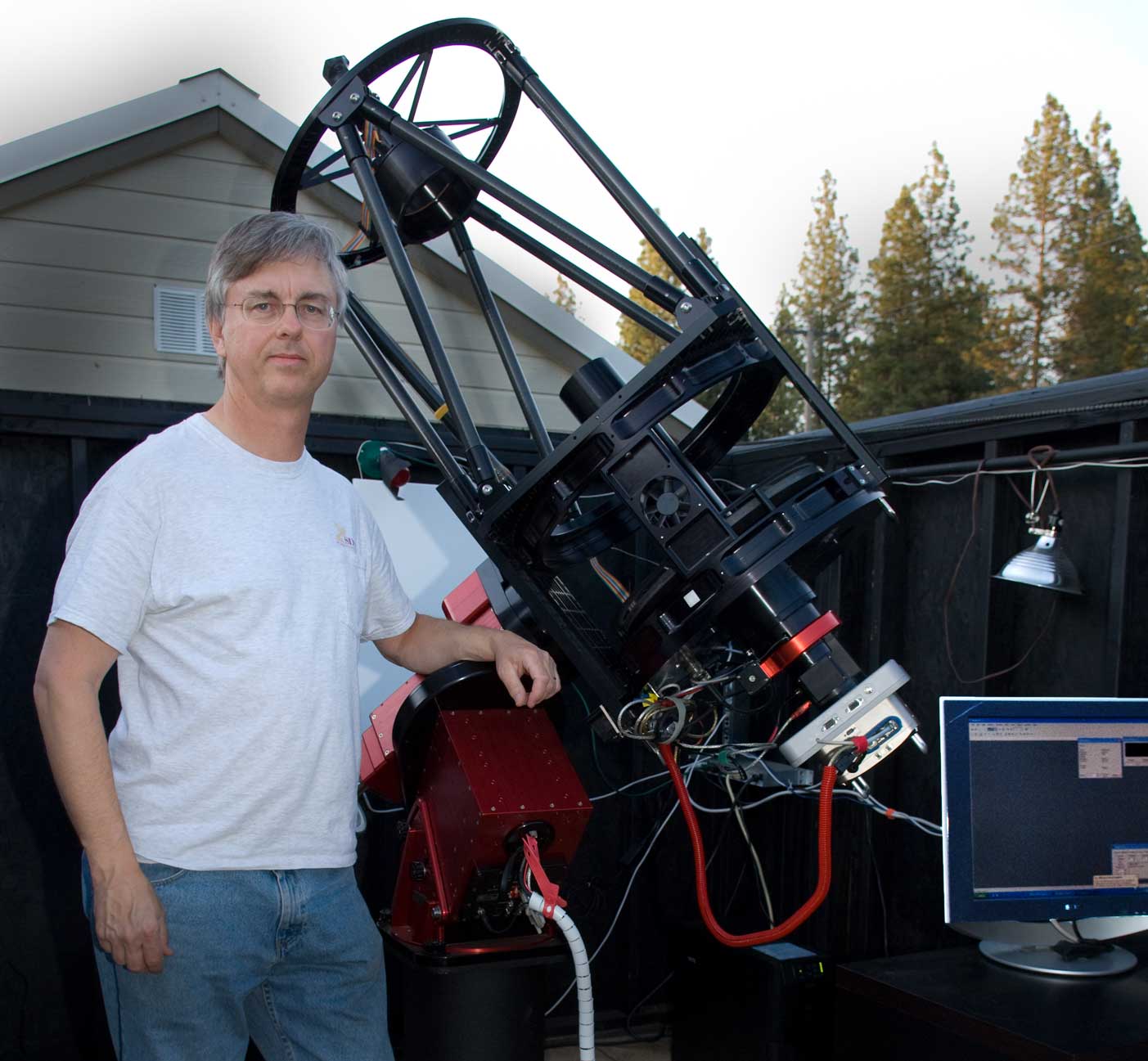
RCOS 16" Open Truss Ritchie-Chretien Telescope at Woodlake Observatory for Testing and Setup
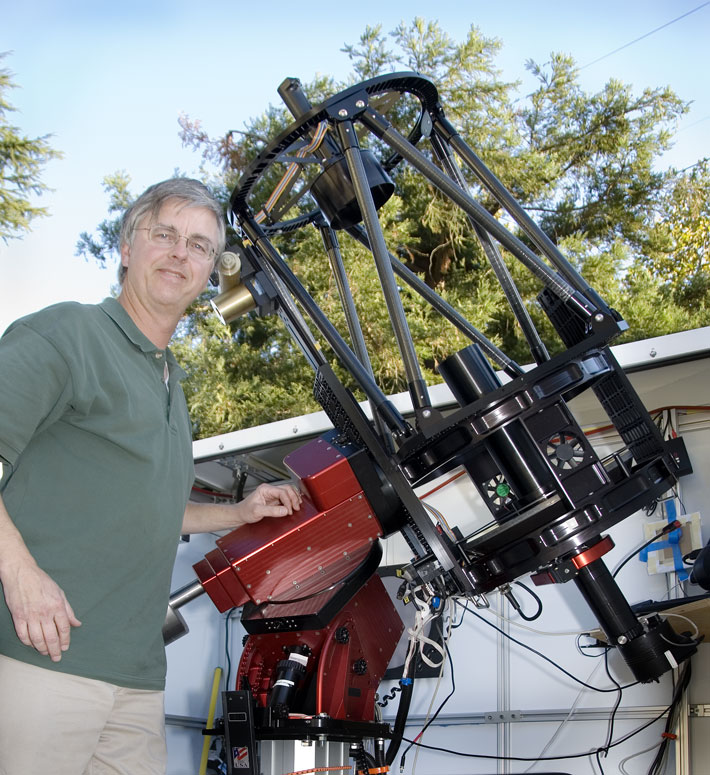 We are back from Southwest trip with my new 16" telescope! This is the scope that I shared with Steve Mandel and Don Goldman at New Mexico Skies for the last year. I decided to bring it home to Sacramento while waiting to build a remote observatory on my sister's property near Shingletown (just below Mount Lassen). This is an RCOS open truss Ritchie-Chretien OTA with ion-milled optics that are refined to better than 1/30 wavelength peak to peak. That's real good stuff. I've made a couple of test exposures and it works great, even after a bumpy thousand-mile ride from Flagstaff.
We are back from Southwest trip with my new 16" telescope! This is the scope that I shared with Steve Mandel and Don Goldman at New Mexico Skies for the last year. I decided to bring it home to Sacramento while waiting to build a remote observatory on my sister's property near Shingletown (just below Mount Lassen). This is an RCOS open truss Ritchie-Chretien OTA with ion-milled optics that are refined to better than 1/30 wavelength peak to peak. That's real good stuff. I've made a couple of test exposures and it works great, even after a bumpy thousand-mile ride from Flagstaff.
Click on image for LARGER version...
Andromeda Galaxy, M31, LRGB from Sacramento
Andromeda is the nearest major galaxy to our own Milky Way Galaxy. Our Galaxy is thought to look much like Andromeda. Together these two galaxies dominate the Local Group of galaxies. The diffuse light from Andromeda is caused by the hundreds of billions of stars that compose it. The several distinct stars that surround Andromeda's image are actually stars in our Galaxy that are well in front of the background object. Andromeda is frequently referred to as M31 since it is the 31st object on Messier's list of diffuse sky objects. M31 is about 2.9 million light years away.
This image is composed of 120 individual exposures through red, green, blue and clear filters. It was necessary to take many short (one-minute) exposures to minimize the limiting effects of local light pollution.
Click on image for LARGER version...
North American and Pelican from Sacramento in Hydrogen-Alpha Light
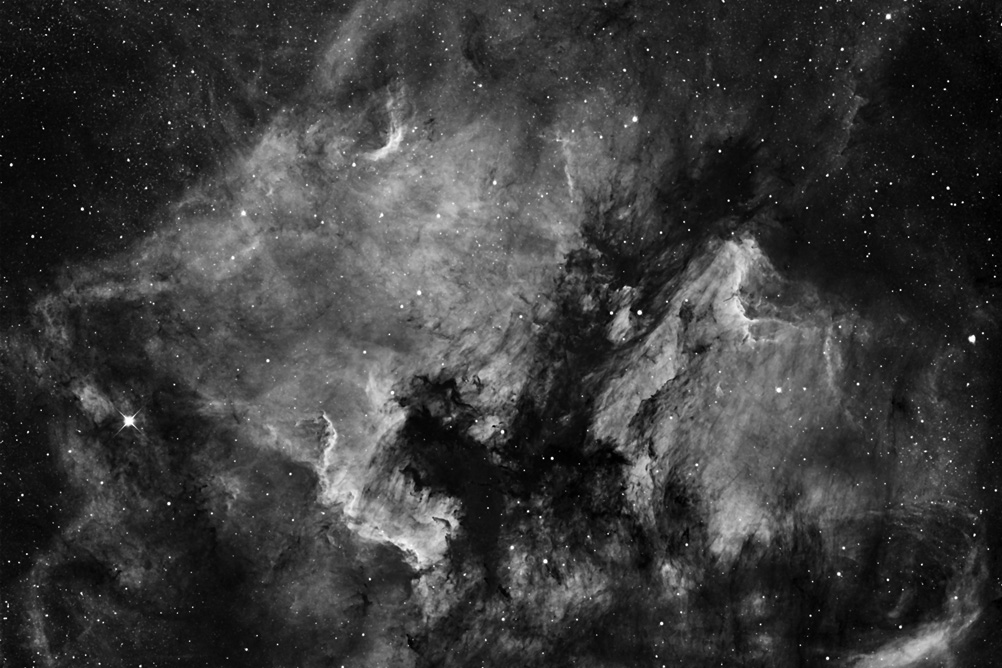 North American (NGC7000) and Pelican (IC5067) Nebulae in hydrogen alpha light. A stack of 12 - 15-minute exposures from Sacramento with a Epsilon 180ED telescope and STL11000 camera with AstroDon 6nm H-a filter. This is a huge gathering of hydrogen gas in the constellation Cygnus, not far from Deneb, one of the stars of the Summer Triangle. This emission nebula is famous partly because it resembles Earth's North American Continent. To the right of the North America Nebula is a less luminous Pelican Nebula. The two emission nebula are located about 1500 light years away and are separated by a dark absorption cloud. The nebulae can be seen without a telescope from a dark location. It is still unknown which star or stars ionize the glowing hydrogen gas.
North American (NGC7000) and Pelican (IC5067) Nebulae in hydrogen alpha light. A stack of 12 - 15-minute exposures from Sacramento with a Epsilon 180ED telescope and STL11000 camera with AstroDon 6nm H-a filter. This is a huge gathering of hydrogen gas in the constellation Cygnus, not far from Deneb, one of the stars of the Summer Triangle. This emission nebula is famous partly because it resembles Earth's North American Continent. To the right of the North America Nebula is a less luminous Pelican Nebula. The two emission nebula are located about 1500 light years away and are separated by a dark absorption cloud. The nebulae can be seen without a telescope from a dark location. It is still unknown which star or stars ionize the glowing hydrogen gas.
Click on image for LARGER version...
Just for Fun: Nine-Image Mosaic of Gamma Cygnus Environs
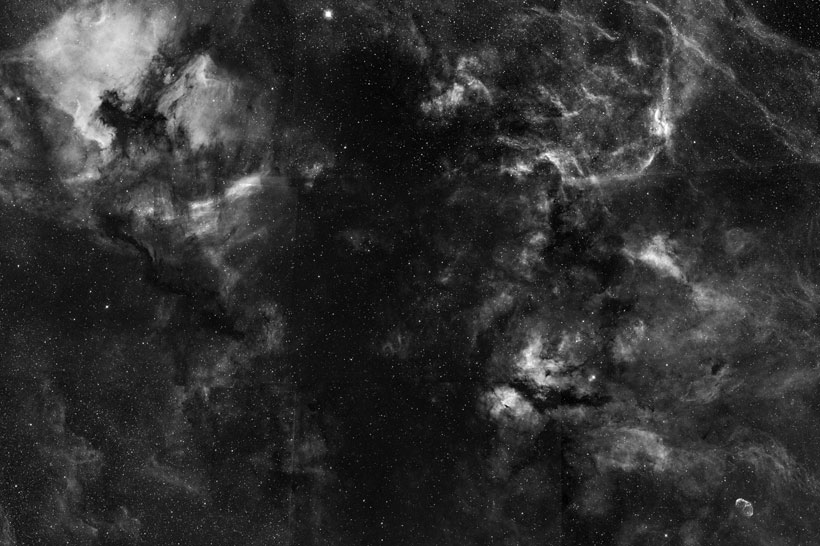 My first try at a mosaic image, this is composited from nine separate H-alpha images taken the early morning of July 9, 2006. The images were brought together in Photoshop CS2 using separate layer groups and clipping masks to allow individual adjustments of levels and curves to match adjoining frames. Some dodging, burning and cloning was also done. This is definitely a work in progress with a lot more effort needed to clean up the frame joints. Lots of work, lots of time, bunches of fun. The LARGER version is still only 1/4 of the original image, but there's lots to look at there. North American and Pelican Nebulae at upper left, Crescent Nebula at lower right. The star at the upper center is Deneb. Gamma Cyg is the star to the upper left of Crescent Nebula. The field of view is 12 degrees wide and 9 degrees high.
My first try at a mosaic image, this is composited from nine separate H-alpha images taken the early morning of July 9, 2006. The images were brought together in Photoshop CS2 using separate layer groups and clipping masks to allow individual adjustments of levels and curves to match adjoining frames. Some dodging, burning and cloning was also done. This is definitely a work in progress with a lot more effort needed to clean up the frame joints. Lots of work, lots of time, bunches of fun. The LARGER version is still only 1/4 of the original image, but there's lots to look at there. North American and Pelican Nebulae at upper left, Crescent Nebula at lower right. The star at the upper center is Deneb. Gamma Cyg is the star to the upper left of Crescent Nebula. The field of view is 12 degrees wide and 9 degrees high.
Click on image for LARGER version...
Recent Work: Crescent Nebula and Environs from Sacramento
 Looking more like another cosmic jellyfish, this nebula is commonly known as the Crescent Nebula. It is one of many interesting forms residing in the constellation Cygnus, which is nearly overhead during Summer nights. This is another narrowband image, combining SII, Ha and OIII image data in this false-color mapped rendition. The color pallet began with the standard Hubble set of mapping SII to red, Ha to green and OIII to blue, but went on to be massaged into a more "artsy" rendition that seems to please the tastes of many who have seen it. It is related to Don Goldman's APOD winning astrophoto of the same subject, but I have taken more liberties with my data.This isn't "serious science", it's my take on fun science. Imaged July 5&6, 2006. Epsilon 180ED. 120 min each SII:Ha:OIII.
Looking more like another cosmic jellyfish, this nebula is commonly known as the Crescent Nebula. It is one of many interesting forms residing in the constellation Cygnus, which is nearly overhead during Summer nights. This is another narrowband image, combining SII, Ha and OIII image data in this false-color mapped rendition. The color pallet began with the standard Hubble set of mapping SII to red, Ha to green and OIII to blue, but went on to be massaged into a more "artsy" rendition that seems to please the tastes of many who have seen it. It is related to Don Goldman's APOD winning astrophoto of the same subject, but I have taken more liberties with my data.This isn't "serious science", it's my take on fun science. Imaged July 5&6, 2006. Epsilon 180ED. 120 min each SII:Ha:OIII.
Click on image for LARGER version...
Recent Work: Veil Nebula Complex from home base in Sacramento
 Don Goldman just got his Epsilon 180 and his first subject from the Sacramento area was this group of several emission nebula in Cygnus. So, I had to go for it too. As did Don, I used one hour each of hydrogen alpha and oxygen III filtered data (15 minute sub exposures). Acquired in CCDSoft with my Epsilon 180ED and STL11000 camera with (of course) AstroDon filters. I processed the data in CCDStack, including minimizing a strong gradient in the OIII image, likely due to a combination of light pollution and the Moon. The color was assembled in Photoshop CS using Ken Crawford's clipping layers method (at least Ken is the guy who showed me this powerful technique, I'm not sure if he "invented" it). R=Ha, G&B=OIII. Don took a look at my initial version and gave me a few suggestions for smoothing things out, and here it is, a "pretty good" shot of the Veil. Click on image at left for full-resolution version, only slightly cropped on left and right sides. The detail in the full-resolution image is amazing to me.
Don Goldman just got his Epsilon 180 and his first subject from the Sacramento area was this group of several emission nebula in Cygnus. So, I had to go for it too. As did Don, I used one hour each of hydrogen alpha and oxygen III filtered data (15 minute sub exposures). Acquired in CCDSoft with my Epsilon 180ED and STL11000 camera with (of course) AstroDon filters. I processed the data in CCDStack, including minimizing a strong gradient in the OIII image, likely due to a combination of light pollution and the Moon. The color was assembled in Photoshop CS using Ken Crawford's clipping layers method (at least Ken is the guy who showed me this powerful technique, I'm not sure if he "invented" it). R=Ha, G&B=OIII. Don took a look at my initial version and gave me a few suggestions for smoothing things out, and here it is, a "pretty good" shot of the Veil. Click on image at left for full-resolution version, only slightly cropped on left and right sides. The detail in the full-resolution image is amazing to me.
Click on image for LARGER version...
Lagoon, Trifid and Friends from Shingletown Star Party - APOD 11/2/2007
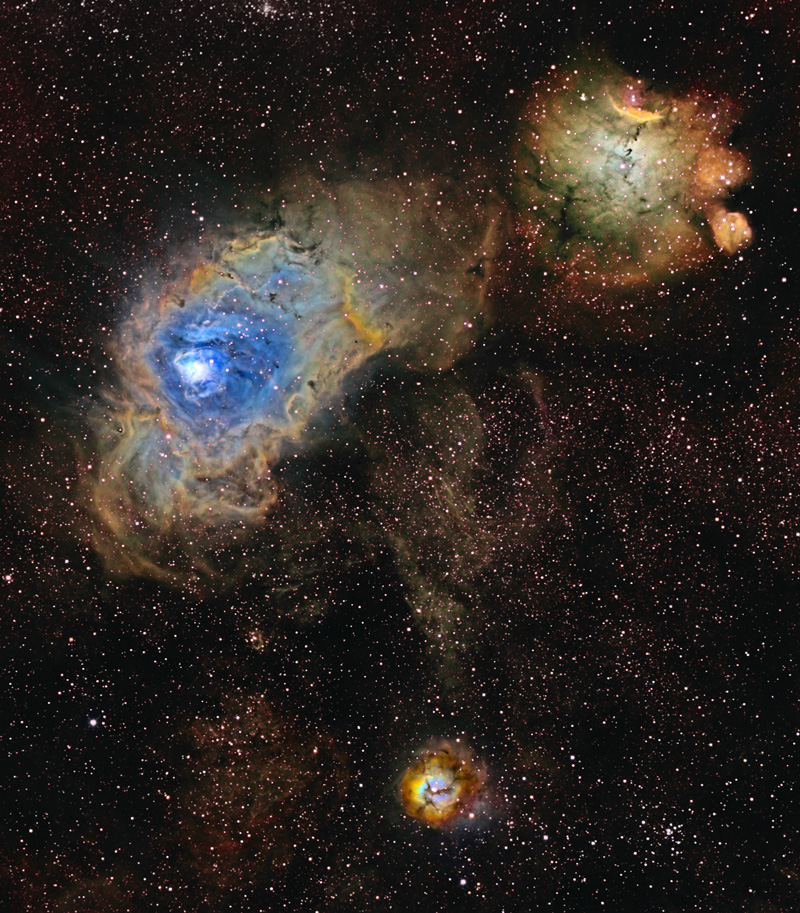 This image was taken at the Shingletown Star Party in June 2006 with my Epsilon 180ED scope and STL11000 camera using Astrodon narrowband filters. Acquired in CCDSoft, processed in CCDStack, and PhotoshopCS. Total exposure time was nearly five hours. The large bluish nebula is the Lagoon, the small blue-redish guy to the left is the Trifid. There is a nice open cluster below the Trifid. The greenish and redish nebula below the Lagoon is IC1275. I don't yet know what the large redish form at the top right is a part of. This is my fifth attempt at getting a satisfying image.
This image was taken at the Shingletown Star Party in June 2006 with my Epsilon 180ED scope and STL11000 camera using Astrodon narrowband filters. Acquired in CCDSoft, processed in CCDStack, and PhotoshopCS. Total exposure time was nearly five hours. The large bluish nebula is the Lagoon, the small blue-redish guy to the left is the Trifid. There is a nice open cluster below the Trifid. The greenish and redish nebula below the Lagoon is IC1275. I don't yet know what the large redish form at the top right is a part of. This is my fifth attempt at getting a satisfying image.
Click on image for LARGER version...
Rosette Nebula Wins Peoples Choice Award at Enotria Gallery May Show
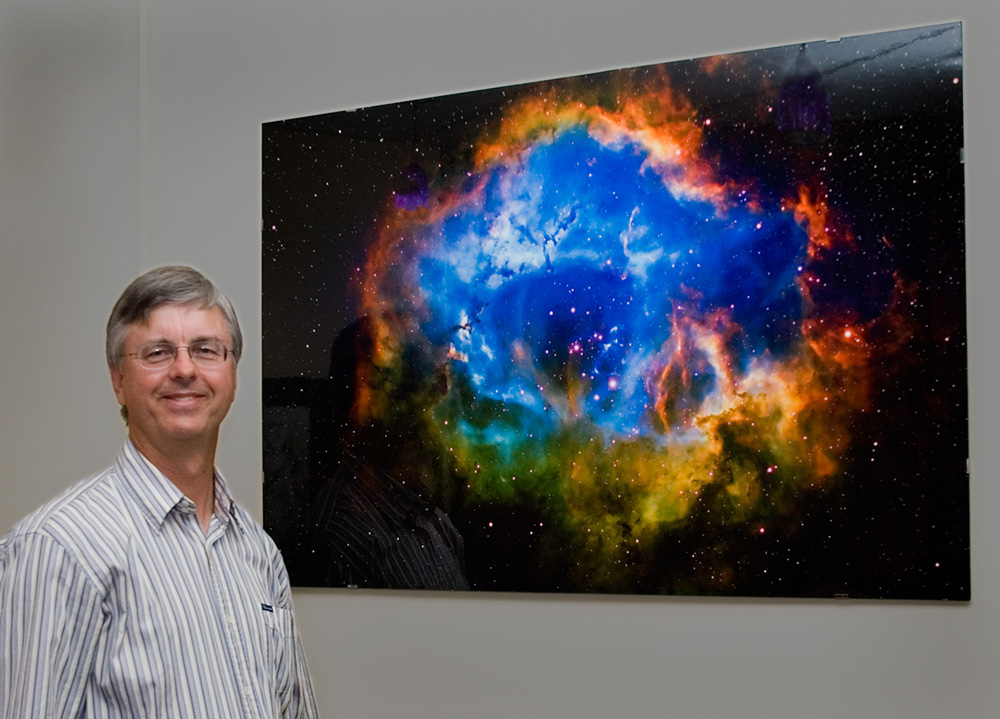 My first public showing of an astronomical image geenerated a great deal of interest at the Enotria Gallery in Sacramento during its May show. Gallery vistors voted it Peoples Choice over an excellent selection of works by eight other artists. During June, my Jellyfish Nebula (below) will be hanging. It generated a lot of comments and questions during Saturday night's opening, part of Sacramento's "Second Saturday Art Walk". Both prints are 30x45 inches and were printed by CaliColor on and Epson 9800 inkjet. Photo at right by Eddie Mayda. Imaged with TOA-150 and STL11000.
My first public showing of an astronomical image geenerated a great deal of interest at the Enotria Gallery in Sacramento during its May show. Gallery vistors voted it Peoples Choice over an excellent selection of works by eight other artists. During June, my Jellyfish Nebula (below) will be hanging. It generated a lot of comments and questions during Saturday night's opening, part of Sacramento's "Second Saturday Art Walk". Both prints are 30x45 inches and were printed by CaliColor on and Epson 9800 inkjet. Photo at right by Eddie Mayda. Imaged with TOA-150 and STL11000.
Click on image for LARGER version...
"Jellyfish" Nebula Narrowband
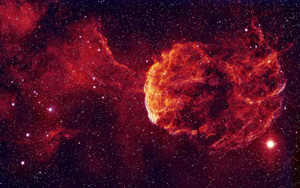 Normally faint and elusive, the Jellyfish Nebula is caught in the net of this wide-field view. This jellyfish is part of bubble-shaped supernova remnant IC 443, the expanding debris cloud from an exploded star some 5,000 light-years away. Like its cousin in astrophysical waters, the Crab Nebula, IC 443 is known to harbor a neutron star, the collapsed core of the massive star that exploded over 30,000 years ago. This image was assembled from four hours of exposures of hydrogen-alpha emissions and seven hours of oxygen-III emissions, all taken from the Woodlake Observatory near downtown Sacramento. Taken a Takahashi TOA-150 (1,100 mm focal length, f/7.3) and SBIG STL-11000xm with AstroDon filters ona Paramount ME.. This image tied for "Peoples Choice" award at June Enotria Gallery show in Sacramento.
Normally faint and elusive, the Jellyfish Nebula is caught in the net of this wide-field view. This jellyfish is part of bubble-shaped supernova remnant IC 443, the expanding debris cloud from an exploded star some 5,000 light-years away. Like its cousin in astrophysical waters, the Crab Nebula, IC 443 is known to harbor a neutron star, the collapsed core of the massive star that exploded over 30,000 years ago. This image was assembled from four hours of exposures of hydrogen-alpha emissions and seven hours of oxygen-III emissions, all taken from the Woodlake Observatory near downtown Sacramento. Taken a Takahashi TOA-150 (1,100 mm focal length, f/7.3) and SBIG STL-11000xm with AstroDon filters ona Paramount ME.. This image tied for "Peoples Choice" award at June Enotria Gallery show in Sacramento.
Click on image for LARGER version...
Rosette Nebula in Narrowband - Voted "Peoples Choice" at Enotria Gallery, May 2006
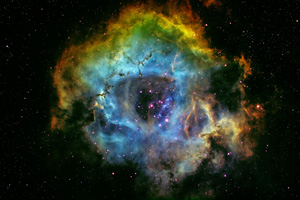 The beautiful Rosette Nebula and other star forming regions are often shown in astronomical images with a predominately red hue - in part because the dominant emission in the nebula is from hydrogen atoms. Hydrogen's strongest optical emission line, known as H-alpha, is in the red region of the spectrum, but the beauty of an emission nebula need not be appreciated in red light alone. Other atoms in the nebula are also excited by energetic starlight and produce narrow emission lines as well. In this widefield view of the Rosette, narrow band images are combined to show emission from sulfur atoms in red, hydrogen in blue, and oxygen in green. This image spans about 150 light-years in the constellation Monoceros, at the 3,000 light-year estimated distance of the Rosette Nebula. It was imaged from Sacramento with a Takahashi TOA-150 refractor at f/7.3. The camera was an SBIG STL-11000 with AstroDon filters. Total exposure time was 14.5 hours. Click on the image for LARGER version...
The beautiful Rosette Nebula and other star forming regions are often shown in astronomical images with a predominately red hue - in part because the dominant emission in the nebula is from hydrogen atoms. Hydrogen's strongest optical emission line, known as H-alpha, is in the red region of the spectrum, but the beauty of an emission nebula need not be appreciated in red light alone. Other atoms in the nebula are also excited by energetic starlight and produce narrow emission lines as well. In this widefield view of the Rosette, narrow band images are combined to show emission from sulfur atoms in red, hydrogen in blue, and oxygen in green. This image spans about 150 light-years in the constellation Monoceros, at the 3,000 light-year estimated distance of the Rosette Nebula. It was imaged from Sacramento with a Takahashi TOA-150 refractor at f/7.3. The camera was an SBIG STL-11000 with AstroDon filters. Total exposure time was 14.5 hours. Click on the image for LARGER version...
New Mexico Skies: M100
 The conditions were so-so at best in New Mexico last night, but I got SOMETHING. Not too bad, considering seeing jumping around from 2 - 4 arc seconds and high clouds cruising by. This is a "true color" version made with ten-minutes each of LRGB binned 2x2 with Astrodon filters on the STL11000 and 16" RCOS scope at New Mexico Skies. Guiding with remote camera head and Don Goldman's ROGUE off-axis rotating guider. Data was acquired with Maxim DL4 and CCDAutopilot 2. Processed and combined in CCDStack, then some hue/saturation and curves applied in Phtoshop CS2. It would be nice to shoot this under better conditions, and unbinned. So much sky, so litle good weather...
The conditions were so-so at best in New Mexico last night, but I got SOMETHING. Not too bad, considering seeing jumping around from 2 - 4 arc seconds and high clouds cruising by. This is a "true color" version made with ten-minutes each of LRGB binned 2x2 with Astrodon filters on the STL11000 and 16" RCOS scope at New Mexico Skies. Guiding with remote camera head and Don Goldman's ROGUE off-axis rotating guider. Data was acquired with Maxim DL4 and CCDAutopilot 2. Processed and combined in CCDStack, then some hue/saturation and curves applied in Phtoshop CS2. It would be nice to shoot this under better conditions, and unbinned. So much sky, so litle good weather...
Click on image for LARGER version...
California Nebula in Ha and SII with Epsilon 180ED
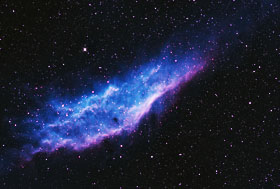 It sorta looks like California, tipped over with North to the left... This is made with the Epsilon 180ED scope (180mm f/2.8) and STL-11000xm camera from home in Sacramento. This version has 100 minutes of H-alpha and 60 minutes of Sulphur II. The Ha was mapped to G and B, and the SII to Red. It was processed in CCDStack and combined and finished in Photoshop. The Ha was grabbed in early February when it was well-up in the sky, while the SII was had in mid-March, with the nebula only about 30 degrees above the western horizon when the last SII image was made. Image is hanging in the July 2006 Enotria Gallery show in Sacramento.
It sorta looks like California, tipped over with North to the left... This is made with the Epsilon 180ED scope (180mm f/2.8) and STL-11000xm camera from home in Sacramento. This version has 100 minutes of H-alpha and 60 minutes of Sulphur II. The Ha was mapped to G and B, and the SII to Red. It was processed in CCDStack and combined and finished in Photoshop. The Ha was grabbed in early February when it was well-up in the sky, while the SII was had in mid-March, with the nebula only about 30 degrees above the western horizon when the last SII image was made. Image is hanging in the July 2006 Enotria Gallery show in Sacramento.
Click on image for LARGER version...
Owl Nebula LRGB imaged from New Mexico Skies
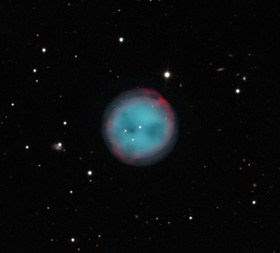 The Owl Nebula, NGC3587. This is latest version which includes luminance data. It is a distinct improvement over my earlier RGB version.. The color here was combined in CCDStack with excellent results. The red rim around the nebula was enhanced slightly in Photoshop using curves. No noise reduction or other smoothing was applied. I am very pleased with the high S/N of the image. All data (one hour each LRGB) was acquired the night of March 4-5, 2006 with the 3GT 16" RCOS at NM Skies.
The Owl Nebula, NGC3587. This is latest version which includes luminance data. It is a distinct improvement over my earlier RGB version.. The color here was combined in CCDStack with excellent results. The red rim around the nebula was enhanced slightly in Photoshop using curves. No noise reduction or other smoothing was applied. I am very pleased with the high S/N of the image. All data (one hour each LRGB) was acquired the night of March 4-5, 2006 with the 3GT 16" RCOS at NM Skies.
Click on image for LARGER version...
Thank you APOD and SEDS for much of the image information cited above...
I hope that your monitor sees all the tones from dark to light:
|
 FSQ106n atop RCOS 10" at Woodlake Observatory. See the "Equipment" section for more information
FSQ106n atop RCOS 10" at Woodlake Observatory. See the "Equipment" section for more information

